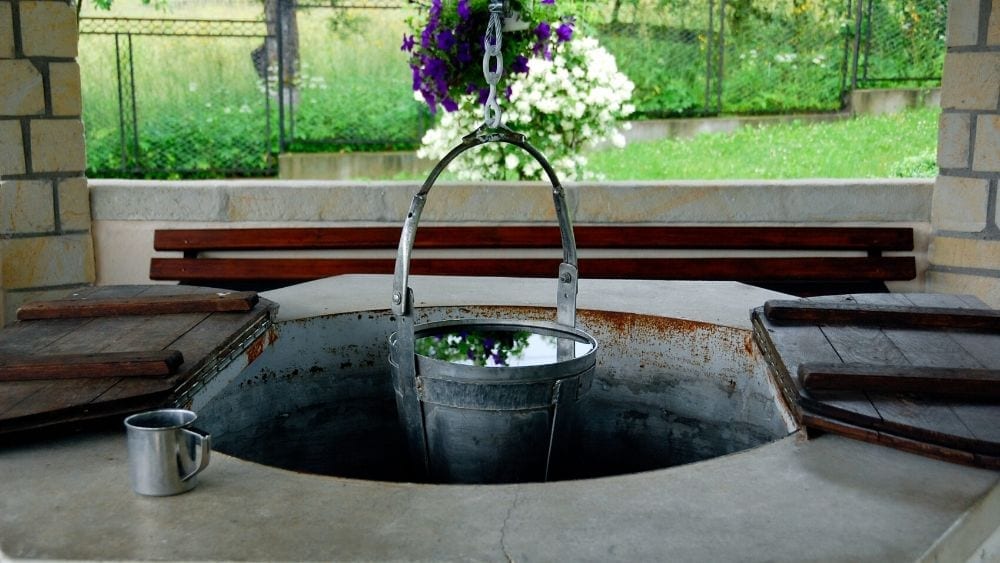
Well, well, well … are you considering a fresh-water investment? Many homeowners report positive outcomes as a result of owning their own water source, such has health-related benefits and less costly monthly expenses. Making the switch to maintaining your own well can offer you the opportunity to enjoy the cool, refreshing taste of all-natural water that is free from city contaminants, harsh chemicals, and those hefty monthly fees.
If you are looking to purchase a house with an existing well, there are several items you will want to familiarize yourself with ahead of time. Consider the type of well, the longevity of the materials and any expected cost in repairs. Be sure to check the filter, if there is one, and consult a professional who is familiar with the local water supply to help you test the well for both quantity and quality prior to making an offer.
If you’re looking for some of the basics when shopping around for a well, read on to discover what you need to know before buying.
Well Types
Dug/Bored Wells
The oldest and most basic concept of the water well is the dug/bored well. These are dug out of the ground by a backhoe and are typically very shallow, maybe 10 to 30 feet deep. The casing of the well is lined with stones or bricks to help the well retain its shape. More importantly, it helps to prevent collapse. However, the walls are not continuously cased, and are therefore susceptible to water contamination.
Driven Wells
Driven wells, similar to bored wells, are very shallow. They are usually about 30 to 50 feet deep and are continuously lined by some form of plastic or piping. Driven wells, however, are also prone to contamination because they dip into aquifers near the surface to draw out water.
Drilled Wells
The third type is the drilled well. These can plunge from 100 to thousands of feet into the ground. They have the lowest risk of contamination due to consistent and sustainable casing. The casing does require a lot of installation, which could cost you anywhere from $5,000 to $15,000 to drill a new well.
Before You Buy
Ask Questions and Do Your Research
When you are shopping around, be sure to ask many questions. Consult a qualified expert to test the water and inspect the well. You may want to ask for records on the well from the seller or seek them from the local municipality. Make sure the well is within compliance of all local and state governing codes to avoid costly fines or fees later.
When you ask about the history, be sure to find out when the well was built and if there was ever a point when the well was not in use. Ask for maintenance logs and warranty information on every piece of the system, including the water pump.
Your well is a part of a system that is connected to a water pump and a pressure tank, and the overall functionality is dependent upon all of these pieces remaining in healthy working condition. Inquire about maintenance history and how often these parts must be inspected. If your water pump is getting close to 10 years old, you should factor the cost of repairs and potential replacement.
Additionally, any property with a well should be on at least two acres of land to prevent cross-contamination with your wastewater disposal. It is a best practice to have your water source located as far as possible from your septic tank, at a minimum of 100 feet apart. Many municipalities also have restrictions on the distance that your septic system must remain away from any source of fresh water to lessen the possibility of contamination.
Testing: Quality and Quantity
Homeowners have individual needs when it comes to water usage, so you will want to test for both quality and quantity. Be sure to consult an expert to confirm that your prospective well can produce enough water to supply your household daily usage and that it is clear of harmful contaminants. Investing in a well that does not meet your requirements will cost you a pretty penny in the long run.
Usually, the first action that any professional will perform during quantity testing is to measure the flow rate. Flow rate, which is expressed in gallons per minute, refers to the rate at which the water is being dispersed from the well. The typical homeowner should expect about 100 gallons per person per day to be used, at a standard flow rate between three to five gallons per minute. Upon inspection of the well, be sure to also check the water storage capacity to ensure that there is enough water to fulfill your household needs.
Specific care should be taken while testing quality of the well water. A sample will be taken from the home tap and sent to a lab for analysis. You will receive records of the results, which should be discussed with a professional who can best advise you on any issues. While some impurities can be mild and viable to live with, other issues should be treated to keep your system and your family safe and healthy.
Maintenance
Filtration Systems
Well water differs from treated city water, and as such, it requires a higher level of filtration. Well owners should consult an expert to interpret the results of well water quality tests to determine exactly what needs should be addressed when investing in a filtration system.
While filtration systems placed on city water typically lessen the amount of sediment or chlorine, the filtration systems for well water supply can be more elaborate. You can have several layers to the filtration system, including the mechanical sediment filter, a water softener to remove iron, and even the ability to disinfect the water using ultraviolet light.
Determine what levels of filtration you need based on your water quality test, and then evaluate whether a point-of-use (POU) or point-of-entry (POE) is a preferred filtration setup. A drinking water system is an example of a point-of-use, where you filter the water as you use it. A whole-house filtration system will treat your water at the point of entry into your home, and will filter the water that is distributed for purposes other than your drinking faucet, such as your washing machine, shower and dishwasher.
Adjusting the Water Pressure
If you are moving from the city to the countryside, it’s likely that your city municipal water supply came with the boost of standard water pressure of 60 psi. With well water, this is a bit more of a challenge to achieve.
If you operate on well water supply and the pressure is low, you should first have your pipes inspected for blockages. Sediment and buildup can clog the waterways over time and decrease your pressure. If you have a new appliance that uses a lot of constant running water, this may also result in a lower pressure.
If neither of these are the case and you are still experiencing low pressure, it is possible to increase the water pressure manually using the well pressure switch. You can either call a professional to do this or do it yourself. Be sure to turn off all electricity powering your water system before you begin the adjustment.
Well Wishes To You!
Maintaining a well is a healthy and safe way to keep your own water supply on tap without being dependent upon municipal city systems. With the right filtration system, accurate testing, and a professional to help ensure that a well can meet your household needs, you will be ready to land your dream countryside home!

Melanie Theriault is a writer, counselor, and lifelong learner. She holds a B.A. in Sociology from Southwestern University, where she discovered her passion for fostering human connection through storytelling.
 Top 10 Safest Cities in Wisconsin
Top 10 Safest Cities in Wisconsin